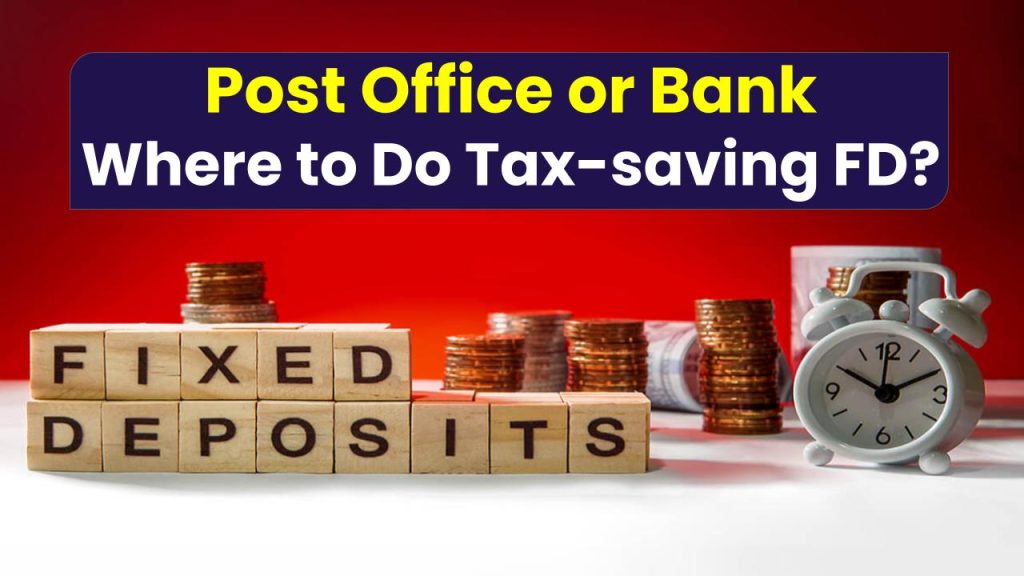
When it comes to securing your savings and reducing your tax burden, tax-saving Fixed Deposits (FDs) are one of the most popular options. But the common question arises — Post Office or Bank, where should you do a tax-saving FD? Understanding the benefits, differences, and which is better suited for your financial goals can help you make an informed decision.
In this article, we’ll break down the key features of Post Office Tax-saving FDs and Bank Tax-saving FDs in a simple yet detailed guide. Whether you’re a beginner or a financial professional, by the end of this, you’ll know exactly which option works best for you.
Post Office vs Bank Tax-saving FD
| Feature | Post Office 5-Year FD | Bank Tax-saving FD |
|---|---|---|
| Interest Rate (March 2025) | 7.5% (fixed) | Varies (6.5% to 7.25% approx., depending on the bank) |
| Lock-in Period | 5 Years | 5 Years |
| Tax Benefit | Eligible for deduction under Section 80C up to ₹1.5 lakh | Same benefit under Section 80C up to ₹1.5 lakh |
| Premature Withdrawal | Not Allowed | Not Allowed |
| Minimum Investment | ₹1,000 | ₹10,000 (varies by bank) |
| Senior Citizen Benefits | No additional interest rate | Generally 0.50% extra interest for senior citizens |
| TDS Deduction | No TDS deducted, but interest taxable | TDS deducted if interest exceeds ₹40,000 (₹50,000 for senior citizens) |
| Safety | Government-backed security | High safety with insured banks (up to ₹5 lakh under DICGC cover) |
So, Post Office or Bank, where should you do your Tax-saving FD? It ultimately depends on your financial goals and preferences. If security, fixed rates, and lower minimum deposits are your priorities, Post Office FDs are a great choice. However, if you want better rates as a senior citizen and easy online management, Bank FDs may be more appealing.Post Office Scheme: Earn Just ₹5,000 and 8 Lakhs Every Month!
What is a Tax-saving FD?
A Tax-saving Fixed Deposit (FD) is a type of investment tool that allows individuals to earn interest on their deposited amount while also offering tax benefits under Section 80C of the Income Tax Act, 1961. Both Post Office and banks provide these 5-year locked-in FDs where you can claim deductions up to ₹1.5 lakh per financial year.
see also: Post Office Scheme: Earn Just ₹5,000 and 8 Lakhs Every Month!
Interest Rates: Post Office vs Bank
Post Office Tax-saving FD
The Post Office 5-Year Time Deposit Scheme currently offers a fixed 7.5% interest rate (January-March 2025). This rate is reviewed quarterly but once you open the FD, the rate is locked for 5 years. The stability and government backing make it a preferred option for risk-averse investors.
Bank Tax-saving FD
Banks offer varying interest rates based on their policies. For example:
- HDFC Bank: 7.00% for regular customers, 7.50% for senior citizens
- Axis Bank: 7.00% for regular customers
- IndusInd Bank: 7.25% for regular customers, up to 7.75% for seniors
- SBI: Around 6.50% – 7.00%
Bank rates might fluctuate, and many private sector banks offer slightly higher rates to attract depositors.
Taxation Rules for Both Options
- Tax Benefit: Both qualify under Section 80C, allowing you to claim a deduction of up to ₹1.5 lakh in a financial year.
- Interest Taxability:
- Bank FDs: TDS at 10% is deducted if interest exceeds ₹40,000 (₹50,000 for senior citizens) per year.
- Post Office FDs: No TDS deduction, but interest income must be declared when filing Income Tax Returns (ITR).
Senior Citizen Advantage
If you’re a senior citizen, banks often give you an additional 0.50% higher interest rate compared to regular customers. Unfortunately, Post Office FDs do not offer this benefit.
Safety & Security Comparison
- Post Office FD: Backed by the Government of India, ensuring complete capital protection and reliability.
- Bank FD: Insured by Deposit Insurance and Credit Guarantee Corporation (DICGC) up to ₹5 lakh per depositor per bank.
Both are highly secure, but for conservative investors, Post Office may offer slightly higher peace of mind due to sovereign guarantee.
Minimum Investment Requirements
- Post Office: Minimum deposit starts at ₹1,000.
- Banks: Usually require a minimum deposit of ₹10,000, though this may differ across banks.
How to Open a Tax-saving FD
Steps to Open Post Office FD:
- Visit your nearest Post Office branch.
- Fill out the Form A for Time Deposit Account.
- Submit required documents like Aadhaar card, PAN card, address proof, and passport-size photo.
- Deposit a minimum of ₹1,000.
- Collect your FD receipt.
Alternatively, Post Office accounts can also be managed via India Post Payments Bank (IPPB) app.
Steps to Open Bank FD:
- Log in to your bank’s internet banking/mobile app or visit the branch.
- Choose “5-Year Tax-saving FD” option.
- Provide your PAN card, Aadhaar card, and KYC documents.
- Deposit the required amount (usually ₹10,000 or more).
- Collect the FD certificate.
see also: Why is PAN Card Necessary? Know Where It Is Used Apart from Paying Tax
Pros and Cons Table
| Aspect | Post Office FD | Bank FD |
|---|---|---|
| Pros | Fixed 7.5% interest, government-backed, low minimum deposit | Flexibility, higher rates for seniors, TDS handled automatically, easy online management |
| Cons | No senior citizen benefits, no premature withdrawal, interest taxable | Interest rate varies, TDS deducted, requires higher minimum deposit |
Post Office or Bank: Tax-saving FD FAQs
1. Can I withdraw my money before 5 years in a Tax-saving FD?
No. Both Post Office and Bank Tax-saving FDs have a mandatory 5-year lock-in period. Premature withdrawal is not permitted.
2. Which FD is safer: Post Office or Bank?
Both are safe. However, Post Office FDs are backed by the Government of India, making them slightly more secure.
3. Is the interest earned from Tax-saving FD tax-free?
No. Interest income is taxable as per your tax slab. However, banks deduct TDS if it crosses the threshold, whereas Post Office does not deduct TDS.
4. Who should choose a Post Office FD?
Investors looking for a safe, government-backed scheme with stable interest rates and a lower minimum deposit.
5. Who should opt for Bank Tax-saving FD?
Those preferring additional benefits for senior citizens, online convenience, or loyalty to a particular bank.











